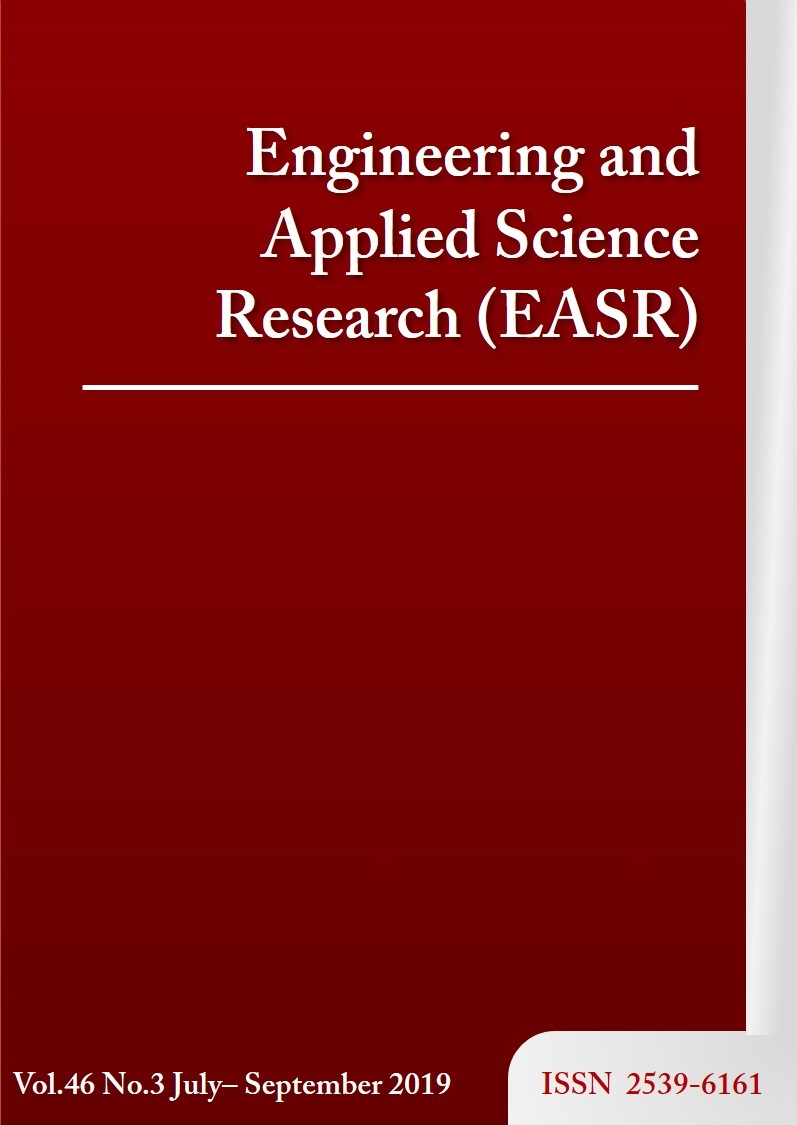Optimization of diesel injection timing, producer gas flow rate, and engine load for a diesel engine operated on dual fuel mode at a high engine speed
Main Article Content
Abstract
Jatropha seed cake is a byproduct of biodiesel production, and the seed cake can be used as a feedstock for a gasifier. The gasified seed cake can partially reduce fossil diesel consumption to run a diesel engine. However, an increase in gas flow rate is associated with a higher diesel substitution rate, but a higher specific CO2 emission is observed. This study attempts to optimize diesel injection timing (DIT), gaseous fuel flow rate, and engine load to offset the specific diesel consumption and the specific CO2 emissions at a high engine speed of 3,000 rpm. Response Surface Methodology (RSM) was applied to statistically develop mathematical models of the response variables as functions of the design variables. A desirability function was then applied to maximize overall desirability. It highlighted that an overall desirability of 0.829 was obtained at 11 before top dead center (BTDC) of the DIT, a 10 kg/h gas flow rate, and 70% of the full engine load. At the optimum operating settings, the specific diesel consumption (SDC) and the specific CO2 emission were 0.0967 kg/kWh and 0.6123 kg/kWh, respectively. A value of electrical-thermal efficiency was found to be 14.10%. It is evident from these findings that a dual producer gas-diesel fuel engine should not be operated at the maximum diesel replacement rate.
Article Details
This work is licensed under a Creative Commons Attribution-NonCommercial-NoDerivatives 4.0 International License.
References
[2] Uma R, Kandpal T, Kishore V. Emission characteristics of an electricity generation system in diesel alone and dual fuel modes. Biomass Bioenerg. 2004;27:195-203.
[3] Sutheerasak E, Pirompugd W, Sanitjai S. Performance and emissions characteristics of a direct injection diesel engine from compressing producer gas in a dual fuel mode. Eng Appl Sci Res. 2018;45(1):47-55.
[4] Sutheerasak E, Pirompugd W, Sanitjai S. Investigation of supercharging producer gas in dual fuel mode on the performance and emissions of a diesel-engine generator. Int J Mater Mech Manuf. 2018;6(6):402-6.
[5] Rith M, Gitano-Briggs HW, Gonzaga JA, Biona JBM. Optimization of control factors for a diesel engine fueled with jatropha seed producer gas on dual fuel mode. Int Energ J. 2019;19(3):149-158.
[6] Shrivastava V, Jha AK, Wamankar AK, Murugan S. Performance and emission studies of a CI engine coupled with gasifier running in dual fuel mode. Procedia Eng. 2013;51:600-8.
[7] Sombatwong P, Thaiyasuit P, Pianthong K. Effect of pilot fuel quantity on the performance and emission of a dual producer gas diesel engine. Energy Procedia. 2013;34:218-27.
[8] Khoobbakht G, Najafi G, Karimi M, Akram A. Optmization of operating factors and blended levels of diesl, biodiesel and ethanol fuels to minimize exhaust emissions of diesel engine using response surface methodology. Appl Therm Eng. 2019;99:1006-17.
[9] IPCC. 2006 IPCC guidelines for national greenhouse gas inventories. Hayama: The Institute for Global Environmental Strategies (IGES); 2006.
[10] Montgomery DC. Design and analysis of experiments. New York: John Wiley & Sons; 2001.
[11] Yaliwal VS, Banapurmath NR, Gireesh NM, Tewari PG. Production and utilization of renewable and sustainable gaseous fuel for power generation applications: a review of literature. Renew Sustain Energ Rev. 2014;34:608-27.
[12] Barik D, Murugan S. Effects of diethyl ether (DEE) injection on combustion performance and emission characteristics of Karanja methyl ester (KME)– biogas fueled dual fuel diesel engine. Fuel. 2016;164:286-96.
[13] Hernandez J, Barba J, Aranda G. Combustion characterization of producer gas from biomass gasification. Global NEST J. 2012;14(2):125-32.
[14] Glaude PA, Fournet R, Bounaceur R, Molière M. Adiabatic flame temperature from biofuels and fossil fuels and derived effect no NOx emissions. Fuel Process Tech. 2010;91:229-35.



